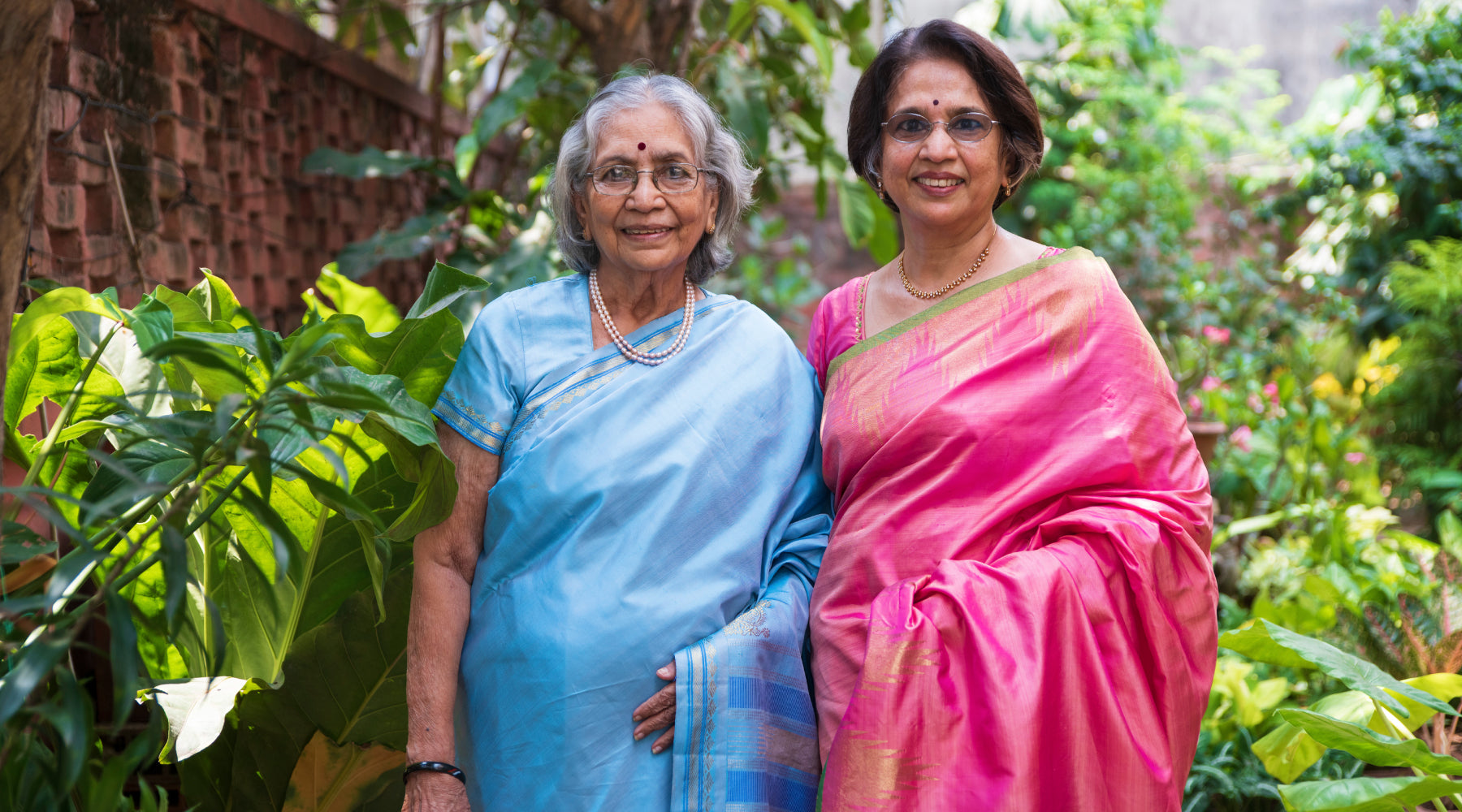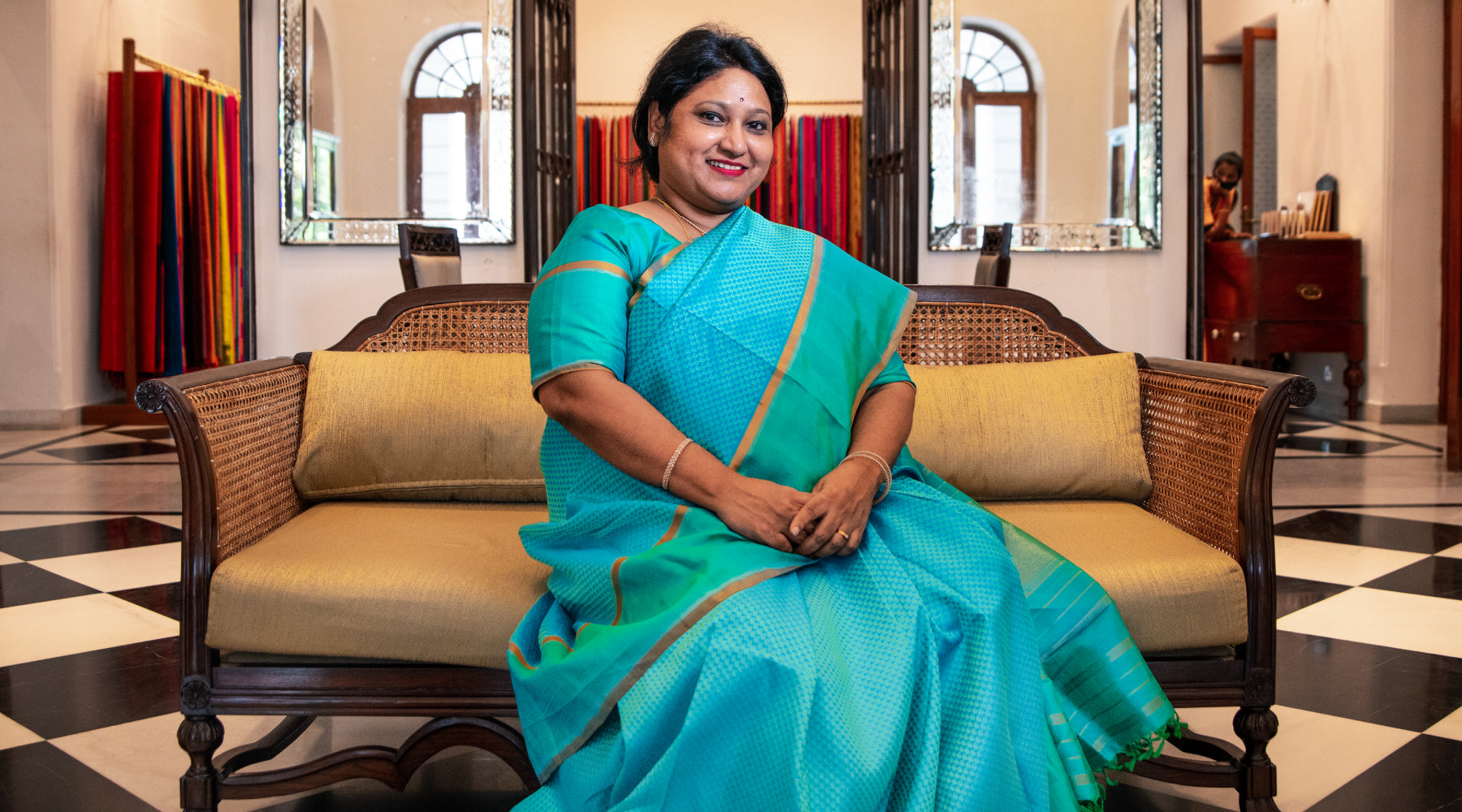KANAKAVALLI VIGNETTES : Manasi Mahesh - Framing Memories

Kanakavalli’s June Vignette Manasi Mahesh, a portrait and wedding photographer, has an energy that’s infectious. When she laughs, you can’t help but laugh with her. With this feature we come full circle, for not long ago, Manasi used to shoot the Vignettes portraits herself. When Manasi lost her father at the age of eleven, she wished that she had more photographs of him to remember him by. And this desire to capture meaningful memories has constantly inspired her on her journey as a photographer. Whether she’s shooting weddings or family portraits, Manasi is always trying to frame fleeting moments of raw emotion and connection—something she manages to do with exquisite skill. For her, beauty lies in how someone makes her feel, and tradition is something she wants to define for herself. In conversation with Aneesha Bangera of The Kanakavalli Journal, Manasi reflects on the struggle to carve her own niche as a photographer, how weddings are more intimate than they used to be, and how people are coming around to the idea of candid photography. Firmly tongue in cheek, Manasi laughingly tells us that she has her entire wedding trousseau planned with her Kanakavalli buys, without a prospective groom on the horizon! She was delighted to curate a selection of kanjivarams for us that reflect her love for beauty. Excerpts from the conversation below…
Framing Memories
Did you always want to become a photographer? Tell us a little bit about how you found your calling.
For as long as I can remember, I’ve been a very visual person. I always learnt things best through pictures. In my Geography exams, my maps would look really beautiful, even if they were sometimes incorrect! I think I realised that I wanted to be a photographer when I was in my last year of school. I used this as an excuse not to study properly for my finals—instead I watched films and learnt about the visual arts as I prepared for my college entrance exams.
I lost my father when I was eleven years old. Since then I’ve always felt as though I never had enough pictures of him. Growing up there were just a couple of photos that I’d keep going back to. I had memories, of course, but I always wished I had more pictures to help me remember more about him and our relationship. I think this played a big part in my decision to study photography.

Above (clockwise from left): Manasi's parents on their honeymoon. Her father was diagnosed with cancer soon after, and they didn't think they would have children; One of the few photographs of Manasi with her father, who she lost when she was eleven years old; A photograph of Manasi and her parents on their new webcam, one of the last pictures of the three of them.
When I was younger I was always taking pictures and videos at every opportunity. I used to go to art classes, and I suspect my art teacher was the only teacher who really liked me. I loved to draw and paint. I was always better at painting than drawing, because I’m drawn to colour more than form. Painting and playing with colour always came more naturally to me, giving me the freedom I enjoyed.
After school, I did an undergraduate degree in Visual Communications at MOP Vaishnav College, after which I went to the US for a Master’s in Photography. I worked in the US for a short while before returning to Chennai, where I now work as a portrait and wedding photographer.

Above: Manasi found this group of friends later in her life, but says they are for keeps. They are always encouraging and supporting each other.
Who or what inspires you the most? Who are the artists who influence you in your work?
I might not have had a strong male figure in my life while growing up, but I’ve always been surrounded by really empowering and inspiring women. Starting with my mother, to my best friends and godmother and many, many more, it has been really amazing to have these strong women role models. I think they have all inspired me in different ways.

Above (Clockwise from left bottom): Manasi with some of her best friends at a wedding where, despite not being family, she tied the third knot of the thali; Manasi and her friends from school who have grown up together; In New York, when Manasi and a group of friends happened to be living in the US at the same time; All dressed up for an immersive theatre experience in London, with a friend who always pushes her out of her comfort zone; Manasi with her friends from college who share many of the same interests.
One of the photographers whose work has really influenced me—perhaps in indirect ways—is Matthew Pillsbury. I first saw his work while working on a college assignment in Atlanta, and I really enjoy his style. He does these beautiful long exposure shots, playing with light, and this effect has always drawn me to his work. I think I try to recreate this in my own photographs—whether it’s a moment at a wedding or an emotion that I’m trying to capture.

Above: 'The Tribute in Light, Sunday September 11th 2011', by Matthew Pillsbury, one of Manasi's favourite photographers
I follow a lot of photographers on social media, and I think it’s nice to see how people can have so many different perspectives. It’s interesting to see things through another person’s eye. I often go back to my older work to see how my style has changed. All the things I’m exposed to subconsciously play a part in how I shoot—and it’s always about telling a visual story in the most powerful way possible.
Tell us about the highs and lows of your job as a photographer. What’s the most memorable experience you’ve had?
The best part about my job is that I get to meet a lot of people. I enjoy shooting anything to do with people, which is why I suppose I ended up being a portrait and wedding photographer. When I start working with clients, they are usually just acquaintances, but by the end of a project they are like friends, and sometimes even like family to me. On multiple occasions, I’ve shot a couple’s engagement, followed by their wedding, then their baby shower, naming ceremony and even their baby’s first birthday. It really feels like becoming a part of the family, and these bonds I create with clients—now friends—is truly special.
For my style of work, weddings are the best place to find the raw emotions and the fleeting moments of meaning that I love to capture. Shooting babies can be challenging when you’re basing so much on the little one’s mood, the environment and the rapport you develop. But I absolutely love the experience. I always end up spending way more time than I need to, playing with the babies and getting to know them and the parents.
In the early years, one of the struggles I faced was in trying to find my target audience. There are just so many people doing so many different kinds of work that I was sometimes not very sure where I fit into the scene, or what my specific category was. More recently, however, I’ve carved a niche for myself and my work. People recognise my style of photography and appreciate that it focuses on the candid.
And of course, not always knowing when the next job will come around can be difficult too. I think that’s why the lockdown hasn’t been as hard for me as it’s been for others—I’m used to some amount of uncertainty in my line of work!
The most memorable experience I’ve had is when a friend of a client, whose wedding event I shot, got in touch with me for her wedding. She had seen one photo from the event, and based on that single photograph, she booked me for her big day. She didn’t even want to see more of my work. I was quite overwhelmed, but the fact that she had complete faith felt really good.

STRANGERS BY TWO
In 2014, during her time in the United States, Manasi undertook a portrait study project. In her own words -"I moved to the United States with a preconceived notion about how life would be here. Coming from a society that values community and togetherness, I was not used to the loneliness that came from living in a world that laid much emphasis on individuality. I was a stranger in a strange space.
The aim of this project has been to transform my discomfort among strangers into something more familiar. Taken as a whole, the stories in this project define the hope and strength that I wish to reinstate. The fleeting interactions with the people that I photograph present a perspective without judgment or pre-conceived notions. Everything is taken at face value."
Below, excerpts from the "Strangers By Two" portrait series -






How do you think weddings and bridal photography have changed over the years?
When I think about different weddings I remember something someone once told me: “You can be the world’s ripest, juiciest, prettiest peach, and there’ll always be someone who doesn’t like peaches.” I think there will always be different people who want different kinds of weddings, based on their circumstances, how they’ve grown up and what they value. And I think that’s great. Having said that, however, I do feel like more young people want their weddings to be intimate and personal. The grandeur of a wedding with ten thousand people is definitely losing its allure.
In terms of wedding photography, I think people are more open to candid images now. This is still difficult though, because everyone is used to having a certain kind of wedding photograph. Some are not sure they want to pay so much for photos in which they may not look ‘perfect’ or ‘flawless’, but they also recognise how special the little moments are.
What are your favourite venues to shoot at?
Outdoor weddings are typically lovely to shoot, because of the light, greenery and decor. I do end up shooting more indoor weddings though, but I still love these. Really, each wedding is completely different from the next, because of the people involved and their story. So, to be honest, the venue is not as important to me as the people and the experience.
The only advice I have for couples planning their wedding is that all that matters is that they choose what they want, because they are going to remember this day for many, many years. It doesn’t have to be fancy or expensive. It just has to be the way they want to remember that day.
How would you describe your visual style? Is this a reflection of who you are as a person?
Most of my images combine two things—what is happening, and people’s reactions. So, at a wedding for example, I’ll have lots of shots of the ceremonies and the action, but more importantly, I’ll try and capture the moments in between. It’s those fleeting emotional reactions, a moment of laughter or tears, that really tell a story.
When I shoot weddings or couple’s portraits, I try to stay connected with the bride and groom. I’m always interacting with them—smiling at them, cracking a joke, making eye contact or reacting to something that’s going on. I think this connection makes them more comfortable in front of the camera. This is sort of how I am—playful, trying to make people laugh, and always staying connected.
Tell us a little bit about what it means to you to be able to weave stories and capture moments of beauty through your lens.
The fact that I don’t have many pictures of my father makes me realise just how valuable a photograph can be. And that’s why I feel really honoured every time someone wants to use my photography as a way to remember something meaningful or important. I hope that when families and couples and children look at my photos years from now, it brings them happiness.
How do you define beauty and tradition?
To me, beauty is just something that sticks with you, something that lasts. I remember people by how they make me feel, and that’s what beauty is to me. I think all the other aspects of beauty only serve to enhance that very specific feeling.
Tradition is something I’ve struggled with. A part of my family is very traditional, and I don’t follow a lot of the traditions that they’d like me to. The reason I don’t is that I think the world is now more progressive and some of those things don’t make sense to me anymore.

I prefer to make my own traditions, based on my beliefs. It might be meeting a friend every last Friday of the month, which makes our bond stronger or gives our relationship more meaning. But wearing new clothes for a festival is not really important to me personally. I think some traditions need to adapt to the times, and if they don’t, then people who hold on to them too rigidly will get left behind. I’m lucky that in my family we can talk about our differences of opinion—trying to understand why some things are so important to us just because we’ve been doing them for so many years. For example, people are always talking about marriage and getting married, and sometimes it seems that being married is more important than the person you’re marrying! And I just can’t understand that.
What is the role of the sari—and the kanjivaram in particular—in your life?
As much as I struggle with tradition, I think my tastes have always leaned towards the more traditional, especially when it comes to the sari. I think Kanakavalli does a fantastic job of keeping tradition alive, while reimagining it in a way that makes it relevant now. I don’t think any other brand is able to bring the same elegance to the kanjivaram.
I have a small collection of saris of my own, most of them from Kanakavalli. My mum and I have very different tastes—I prefer pastels and simple, muted tones, and she calls me boring! I’m drawn to Kanakavalli’s Vault kanjivarams. In fact, I already have my wedding saris ready even though I haven’t found a groom yet, and they are all from Kanakavalli’s Vault range! My mother wasn’t too thrilled about the idea because it goes against tradition to buy wedding saris without even having a groom, let alone a wedding date. But I went ahead, and the groom can come along whenever he does!
Tell us the story behind the kanjivaram you chose to wear for Vignettes.
I ended up wearing one of my ‘wedding’ saris for a friend’s wedding recently, since it doesn’t look like I’m getting married anytime soon. This is the same one I wore for the Vignettes shoot—it’s one of my absolute favourites.

Manasi is wearing a gorgeous kanjivaram from our Vault collective in pale lavender shot with silver grey and dotted with floral buttis in silver zari. Silver and gold geometric patterns adorn the border amid hints of violet, while the pallu features a twill band flanked by motifs in silver and gold.
- Manasi Mahesh, in conversation with Aneesha Bangera, photography by Raghuram Vedant.
View Manasi's accompanying guest curation here.



